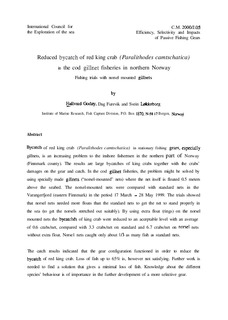Reduced bycatch of red king crab (Paralithodes camtschatica) in the cod gillnet fisheries in northern Norway: Fishing trials with norsel mounted gillnets
Working paper

Åpne
Permanent lenke
http://hdl.handle.net/11250/100447Utgivelsesdato
2000Metadata
Vis full innførselSamlinger
Sammendrag
Bycatch of red king crab (Paralithodes camtschatica) in stationary fishing gears, q&ally
gillnets, is an increasing problem to the inshore fishermen in the northern part of Norway
(Finnmark county). The results are large bycatches of king crabs together with the crabs’
damages on the gear and catch. In the cod gillnet fisheries, the problem might be solved by
using specially made gillnets (“norsel-mounted” nets) where the net itself is floated 0.5 meters
above the seabed. The norsel-mounted nets were compared with standard nets in the
Varangerfjord (eastern Finnmark) in the period 17 March - 28 May 1999. The trials showed
that norsel nets needed more floats than the standard nets to get the net to stand properly in
the sea (to get the norsels stretched out suitably). By using extra float (rings) on the norsel
mounted nets the bycatches of king crab were reduced to an acceptable level with an average
of 0.6 crabs/net, compared with 3.3 crabs/net on standard and 6.7 crabs/net on nor-se1 nets
without extra float. Norse1 nets caught only about l/3 as many fish as standard nets.
The catch results indicated that the gear configuration functioned in order to reduce the
bycatch of red king crab. Loss of fish up to 65% is, however not satisfying. Further work is
needed to find a solution that gives a minimal loss of fish. Knowledge about the different
species’ behaviour is of importance in the further development of a more selective gear.
Utgiver
ICESSerie
ICES CM documents2000/J:05